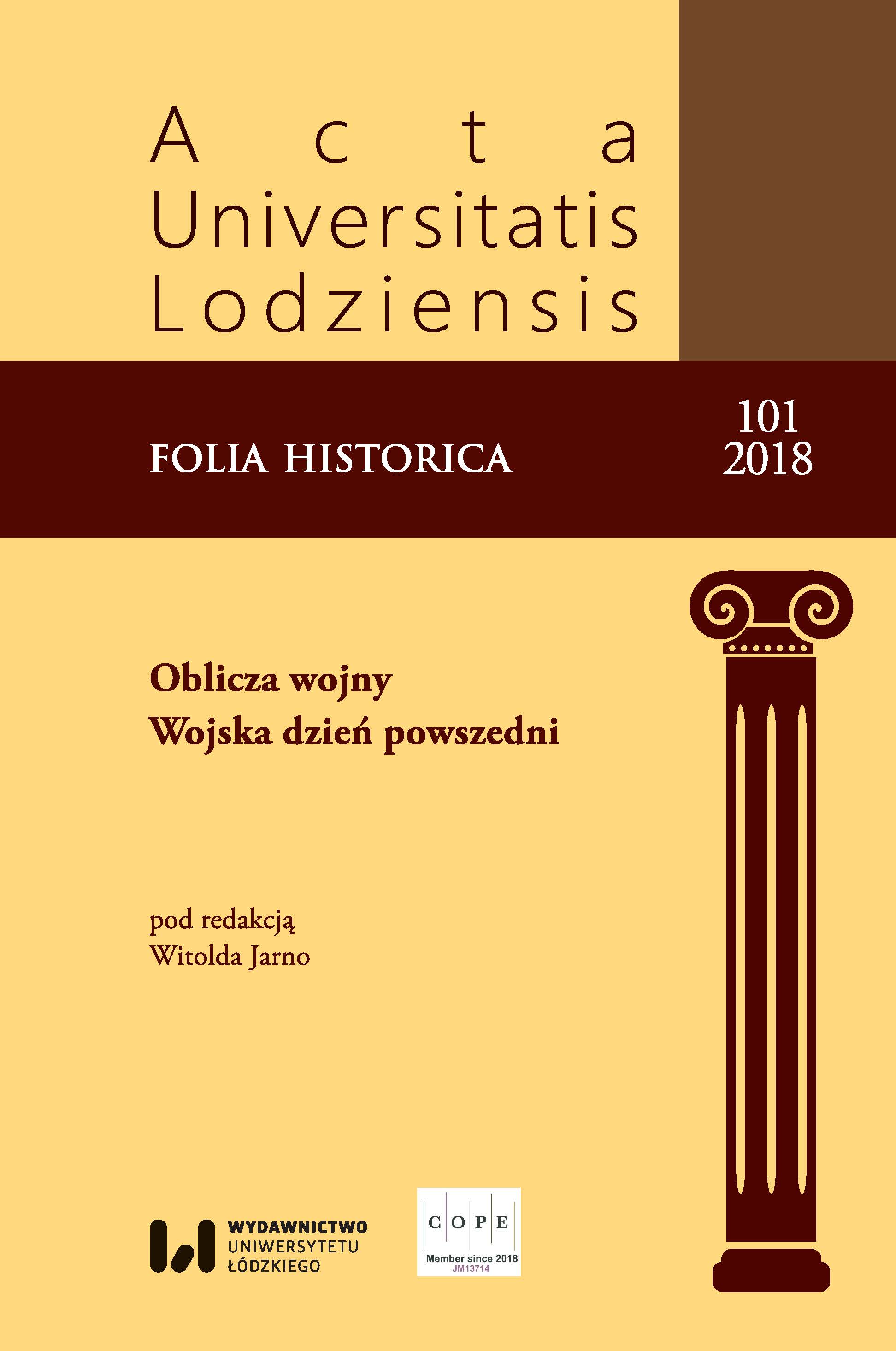Podstawy kształtowania etosu artylerzysty w garnizonie Węgorzewo na przełomie XX i XXI wieku
DOI:
https://doi.org/10.18778/0208-6050.101.14Słowa kluczowe:
etos, artylerzysta, garnizon Węgorzewo, infrastruktura wojskowa, tradycjaAbstrakt
Problemem naukowym artykułu jest zdefiniowanie etosu żołnierskiego podczas wykonywania zadań w Siłach Zbrojnych na przełomie XX i XXI w. W tym celu uznano, że m.in. miejsce pełnienia służby, tradycja oraz wychowanie wojskowe kształtują etos żołnierski. W artykule podjęto próbę oceny, w jakim zakresie wymienione wartości stały się podstawą kształtowania etosu artylerzysty w garnizonie Węgorzewo we wskazanym okresie. Od 1949 r. w garnizonie Węgorzewo istnieje jednostka artyleryjska. Na przestrzeni lat zmieniała się jej nazwa, podporządkowanie i zakres realizowanych zadań. To wpłynęło na ukształtowanie się garnizonu artyleryjskiego z rodowodem i doświadczeniem bojowym. Badania nad etosem żołnierskim nawiązują do działalności 1 Mazurskiej Brygady Artylerii im. gen. Józefa Bema, funkcjonującej od 3 września 1993 r. do 31 grudnia 2010 r., która rozkazem przełożonych została przeformowana w 11 Mazurski Pułk Artylerii z dniem 1 stycznia 2011 r. Przejął on dalej tradycje swojej poprzedniczki oraz brygad artylerii, wcześniej stacjonujących w Węgorzewie. Pułk artylerii jest samodzielnym oddziałem wojsk rakietowych i artylerii, podległym bezpośrednio dowódcy wojsk lądowych i realizuje podobne zadania jak wcześniejsze brygady.Pobrania
Bibliografia
1 Brygada Artylerii. Wspomnienia, kalendarium, symbole, red. W.B. Łach, Węgorzewo 2003.
Google Scholar
Bardzik P., Podstawowy sprzęt artyleryjski „Węgorzewskiej” 1. Brygady Artylerii w latach 1943– 1989, [w:] Garnizony artyleryjskie na Warmii i Mazurach, cz. 2 (Artyleria polska w XX wieku. W 70 rocznicę powstania 1 Warszawskiej Brygady Artylerii Armat im. gen. J. Bema w Węgorzewie), red. W.B. Łach, Węgorzewo 2014, s. 154–165.
Google Scholar
Karuzo R., Dzieje Garnizonu Węgorzewo w latach 1934–1945, [w:] Wojsko na Mazurach na przestrzeni dziejów. Wojsko na Ziemi Węgorzewskiej, red. W.B. Łach, Węgorzewo 2001, s. 87–91.
Google Scholar
Kraszewski J., Zakończenie, [w:] Garnizony artyleryjskie na Warmii i Mazurach, cz. 2 (Artyleria polska w XX wieku. W 70 rocznicę powstania 1 Warszawskiej Brygady Artylerii Armat im. gen. J. Bema w Węgorzewie), red. W.B. Łach, Węgorzewo 2014, s. 279–280.
Google Scholar
Łach W.B., Warmia i Mazury w systemie obronnym Polski po II wojnie światowej – jednostki liniowe Wojska Polskiego w wybranych garnizonach, [w:] Wojsko Polskie w nowej rzeczywistości społeczno-politycznej po II wojnie światowej, red. H. Łach, Olsztyn 2016, s. 169–190.
Google Scholar
Mróz M., Traktat o Konwencjonalnych Siłach Zbrojnych w Europie (CFE), Kancelaria Sejmu. Biuro Studiów i Ekspertyz 1995, nr 74.
Google Scholar
Pawlica E., Mazurska przygoda. Moje wspomnienia z dowodzenia 1. Mazurską Brygadą Artylerii w Węgorzewie w latach 1994–2003, [w:] Garnizony artyleryjskie na Warmii i Mazurach, cz. 2 (Artyleria polska w XX wieku. W 70 rocznicę powstania 1 Warszawskiej Brygady Artylerii Armat im. gen. J. Bema w Węgorzewie), red. W.B. Łach, Węgorzewo 2014, s. 200–252.
Google Scholar
Pawlica E., Łach W.B., Godlewski D., 1 Mazurska Brygada Artylerii im. gen. Józefa Bema. Tradycja i współczesność, Olsztyn 1998.
Google Scholar
Pietrzak W., Brygada w okresie wielkich zmian, [w:] Garnizony artyleryjskie na Warmii i Mazurach, cz. 2 (Artyleria polska w XX wieku. W 70 rocznicę powstania 1 Warszawskiej Brygady Artylerii Armat im. gen. J. Bema w Węgorzewie), red. W.B. Łach, Węgorzewo 2014, s. 195–199.
Google Scholar
Warszawski Okręg Wojskowy. Historia i współczesność, red. W. Rozbicki, Warszawa 1997.
Google Scholar
Ziniewicz M., Wojskowa infrastruktura techniczna z czasów I wojny światowej obecnie wykorzystywana przez Resort Obrony Narodowej, [w:] Wielka wojna na Mazurach 1914–1915. Studia z dziejów frontu wschodniego I wojny światowej, red. R. Kempa, Giżycko 2014, s. 499–431.
Google Scholar
Decyzja nr 229/MON Ministra Obrony Narodowej z dnia 11 VIII 2004 r. w sprawie dziedziczenia i kultywowania tradycji oręża polskiego, http://www.wojsko-polskie.pl/f/pages/atts/2016/5/decyzja_ nr_229_mon_ z_dnia_11_sierpnia_2004_r_w_sprawie_dziedziczeni (dostęp: 12 I 2018).
Google Scholar
HSW SA: 155 mm samobieżna haubica L52 kal. „Krab”, http://promilitaria21.home.pl/autoinstalator/joomla/innowacje-i-biznes/item/4022-hsw-sa-155-mm-samobiezna-haubica-l-52-k (dostęp: 15 I 2017).
Google Scholar
Wiceminister Obrony Narodowej na obchodach Święta Obrony Narodowej na obchodach Święta 11 Pułku Artylerii, http://11pa.wp.mil.pl/ (dostęp: 25 I 2018).
Google Scholar
Wydarzenia pułkowe 2015 r., http://11pa.wp.mil.pl/ (dostęp: 8 II 2018).
Google Scholar
Pobrania
Opublikowane
Jak cytować
Numer
Dział
Licencja

Utwór dostępny jest na licencji Creative Commons Uznanie autorstwa – Użycie niekomercyjne – Bez utworów zależnych 4.0 Międzynarodowe.











